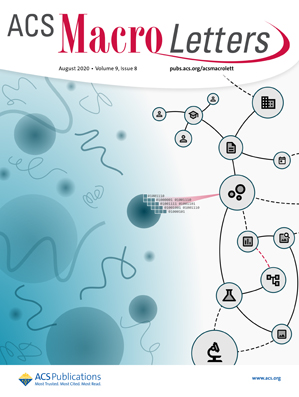Diels-Alder共价自适应网络形态变形的区域化学控制。
IF 5.2
Q1 POLYMER SCIENCE
引用次数: 0
摘要
我们证明Diels-Alder (DA)反应中的区域异构提供了一种微妙而强大的方法来调节动态聚合物网络的热力学和形状变形行为。在这里,我们直接比较了DA聚合物(DAP)网络由具有相同骨架但含有2-或3-取代呋喃悬垂基团的线性聚合物构建而成。对于大范围的交联度,3-取代DAP (3-DAP)网络表现出更高的热稳定性,其反da解离温度(TrDA)为~ 150°C,而2-取代的对应物为120°C,弹性模量更高,温度依赖性应力松弛率显著降低。利用2-和3-DAP弹性体的应力松弛率差异来证明通过选择性网络塑化在双层结构中控制弯曲。此外,由于较高的TrDA值,在单材料结构中使用3-DAP弹性体为形状变形打开了更宽和更高的温度窗口(即在80至140°C之间),这比传统使用的基于da的网络(如2-DAP弹性体)更实用,后者只能在60至90°C之间变形。这些发现确立了呋喃环的区域异构体是设计基于da的形状变形材料的有力参数。本文章由计算机程序翻译,如有差异,请以英文原文为准。
Regiochemical Control of Shape Morphing in Diels-Alder Covalent Adaptable Networks.
We demonstrate that regioisomerism in Diels-Alder (DA) reactions offers a subtle yet powerful way to tune the thermomechanical and shape morphing behavior of dynamic polymer networks. Here, we directly compare DA polymer (DAP) networks built from linear polymers with identical backbones but containing either 2- or 3-substituted furan pendant groups. For a wide range of cross-linking degrees, the 3-substituted DAP (3-DAP) networks exhibited higher thermal stability, with retro-DA dissociation temperatures (TrDA) of ∼150 °C versus 120 °C for the 2-substituted counterparts, higher elastic moduli and significantly slower temperature-dependent stress relaxation rates. The difference in the stress relaxation rates of 2- and 3-DAP elastomers was leveraged to demonstrate controlled bending in a bilayer structure via selective network plasticization. Moreover, due to the higher TrDA values, the use of 3-DAP elastomers in the single-material constructs opened a wider and a higher-temperature window (i.e., between 80 and 140 °C) for shape morphing, which is more practical compared to the traditionally employed DA-based networks such as 2-DAP elastomers which could be morphed only between 60 and 90 °C. These findings establish regioisomerism in the furan ring as a powerful parameter for designing DA-based shape morphing materials.
求助全文
通过发布文献求助,成功后即可免费获取论文全文。
去求助
来源期刊
CiteScore
10.40
自引率
3.40%
发文量
209
审稿时长
1 months
期刊介绍:
ACS Macro Letters publishes research in all areas of contemporary soft matter science in which macromolecules play a key role, including nanotechnology, self-assembly, supramolecular chemistry, biomaterials, energy generation and storage, and renewable/sustainable materials. Submissions to ACS Macro Letters should justify clearly the rapid disclosure of the key elements of the study. The scope of the journal includes high-impact research of broad interest in all areas of polymer science and engineering, including cross-disciplinary research that interfaces with polymer science.
With the launch of ACS Macro Letters, all Communications that were formerly published in Macromolecules and Biomacromolecules will be published as Letters in ACS Macro Letters.

 求助内容:
求助内容: 应助结果提醒方式:
应助结果提醒方式:


